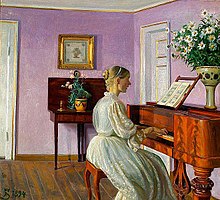Anna Syberg
Anna Louise Birgitte Hansen , married Syberg * ( January 7, 1870 in Faaborg ; † July 4, 1914 in Copenhagen ) was a Danish painter. Like her husband Fritz Syberg , she belonged to the Fynboerne artists' group , an association of painters and graphic artists living and working on the island of Funen .
First years
Anna Hansen grew up in a very lively creative environment in Faaborg. Her father, the decorative painter Peter Syrak Hansen (1833–1904), ran an open house primarily for local painters and art students. It was here that Anna met her future husband, Fritz Syberg, who completed an apprenticeship as a decorative painter with her father until 1982. Anna received piano lessons and drawing and painting lessons from her father. Her brother Peter Hansen later made a name for himself as a painter. After attending the technical school in Faaborg, Anna Hansen trained in 1890 with the sculptor Ludvig Brandstrup and the landscape painter Karl Jensen in Copenhagen. From 1892 to 1894 she worked as a porcelain painter at the royal porcelain factory in Copenhagen. She specialized in flower painting, especially violets and chrysanthemums . She also gave piano and singing lessons. In 1894 she married Fritz Syberg.
Create
In 1902 the couple moved to Pilegården in Kerteminde . Her friends, the painters Alhed and Johannes Larsen and a number of other artists, such as Johannes V. Jensen , who later received the Nobel Prize in Literature , already lived there .
Anna Syberg devoted herself to watercolor painting , preferably the arrangements of flowers and plants. Whereby she used a layer-on-layer technique, similar to the one she had got to know while painting porcelain and which gave her pictures a special luminosity. Although her works were shown between 1989 and 1910 at the spring exhibitions at Charlottenborg Palace in Copenhagen and at autumn exhibitions, she was largely denied recognition of her artistic achievements during her lifetime.
Like her husband, Anna Syberg belonged to the Fynboerne artist group. When Fritz Syberg earned a large amount of money by selling his pictures, the couple decided to provide a financial basis for a Faaborg Museum to be founded, which was to be primarily dedicated to the Funen painters. The idea prevailed and the museum was inaugurated in 1910. The commission that determined which paintings should be bought for the museum consisted entirely of men. It turned out that they only selected works by their male colleagues. According to the minutes, Anne Syberg's brother Peter Hansen and Alhed Larsen's husband Johannes Larsen, in particular, opposed buying the works from female members of the artist colony. Only two years after Anna Syberg's death did the museum honor her work with an extensive solo exhibition.
Anna Syberg gave birth to seven children. She died of a gallbladder infection in 1914 at the age of 44. Her son Ernst Syberg became a painter and illustrator, son Fritz Syberg made a name for himself as a composer.
literature
- Vera Rasmussen: Anna Syberg. In: Kunstineks Danmark & Weilbachs Kunstnerleksikon. (Danish)
- Karin Meisl: Anna Syberg. In: Dansk Kvindebiografisk Leksikon. ( kvinfo.dk )
Web links
Individual evidence
- ^ Elisabeth Fabritius : The Denmark of the artist colonies. Faaborg Museum, Faaborg 2006, p. 18.
| personal data | |
|---|---|
| SURNAME | Syberg, Anna |
| ALTERNATIVE NAMES | Hansen, Anna Louise Birgitte (full name); Syberg, Anna |
| BRIEF DESCRIPTION | Danish painter, porcelain painter |
| DATE OF BIRTH | January 7, 1870 |
| PLACE OF BIRTH | Faaborg |
| DATE OF DEATH | 4th July 1914 |
| Place of death | Copenhagen |





